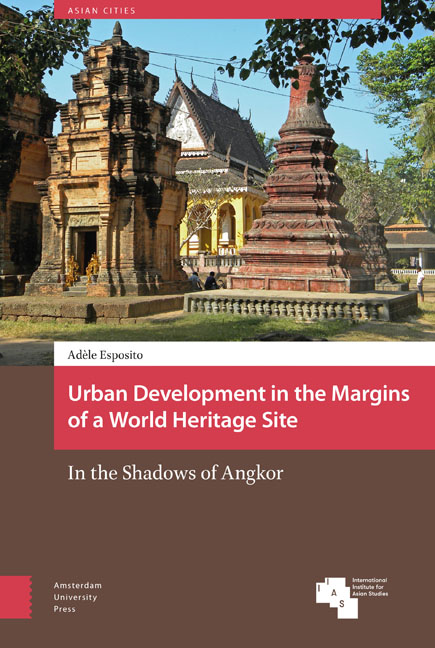Book contents
- Frontmatter
- Dedication
- Contents
- List of Figures
- Abbreviations
- Glossary of Khmer terms
- Acknowledgements
- Author’s Preface
- Introduction
- 1 ‘Before you Build a Wall, Think of What You are Leaving Outside it’: The Construction of Core and Marginal Spaces in the Angkor Region
- 2 The Arena of Urban Planning and the Idea of the City
- 3 The City as Developers’ Playground
- 4 The Architectural Space: How Contemporary Design Shapes Urban Identities and Ideas of Modernity
- Conclusion
- Bibliography
- Index
- Publications / Asian Cities
- Frontmatter
- Dedication
- Contents
- List of Figures
- Abbreviations
- Glossary of Khmer terms
- Acknowledgements
- Author’s Preface
- Introduction
- 1 ‘Before you Build a Wall, Think of What You are Leaving Outside it’: The Construction of Core and Marginal Spaces in the Angkor Region
- 2 The Arena of Urban Planning and the Idea of the City
- 3 The City as Developers’ Playground
- 4 The Architectural Space: How Contemporary Design Shapes Urban Identities and Ideas of Modernity
- Conclusion
- Bibliography
- Index
- Publications / Asian Cities
Summary
The archaeological park of Angkor includes the major monuments of the ancient Khmer capitals, built between the ninth and fifteenth centuries, with ruins and monuments dotting a landscape of tropical forest, cultivated land, and rural communities (Winter, 2008). UNESCO established this park as a consequence of the listing of Angkor as a World Heritage Site in 1992. Aiming to preserve the monuments’ physical authenticity and visual integrity, international experts proposed that only projects for heritage conservation and tourism management should be allowed within the precincts of the park. Its boundaries are marked by small, red pillars displaying the symbol of the UNESCO World Heritage Convention. Beneath the symbol, a double arrow indicates the perimeter of the archaeological park. These pillars are sometimes found in the countryside, where they arbitrarily distinguish an ‘inside’ and ‘outside’ of the park in rural and village environments where neither monuments, nor tourists are in sight (Figure B). A hierarchy was thus established in which a different status was assigned to spaces that often had similar physical and social characteristics, but which arbitrarily fell inside or outside the perimeter of the archaeological park, depending on their distance from the major monuments.
The establishment of the park led to the formation of a ‘heritage territoriality’, that is to say a territory composed of different spaces separated by boundaries, subject to specific sets of regulations, and infused with diverse social and cultural meanings. In particular, the creation of the park has generated what I call a ‘non-heritage space’. I use this neologism to designate an area excluded from heritage recognition, but within the orbit of the heritage site. This space undergoes intense transformation because of its proximity to and concomitant exclusion from heritage status. Here, a politically and socially constructed distinction allows for the implementation of tourism-related developments that would be forbidden within the archaeological park. The non-heritage space therefore absorbs the carry-over effects of tourism growth, but is excluded from the recognition of values that its own legacy and traditions may possess. By the same token, it is also ‘freed from’ the constraints and regulations that are likely to accompany heritage recognition. It can thus be used as a space of development, where aspirations for social change, economic growth, and modernization find their way through new plans and projects.
- Type
- Chapter
- Information
- Urban Development in the Margins of a World Heritage SiteIn the Shadows of Angkor, pp. 23 - 50Publisher: Amsterdam University PressPrint publication year: 2018



